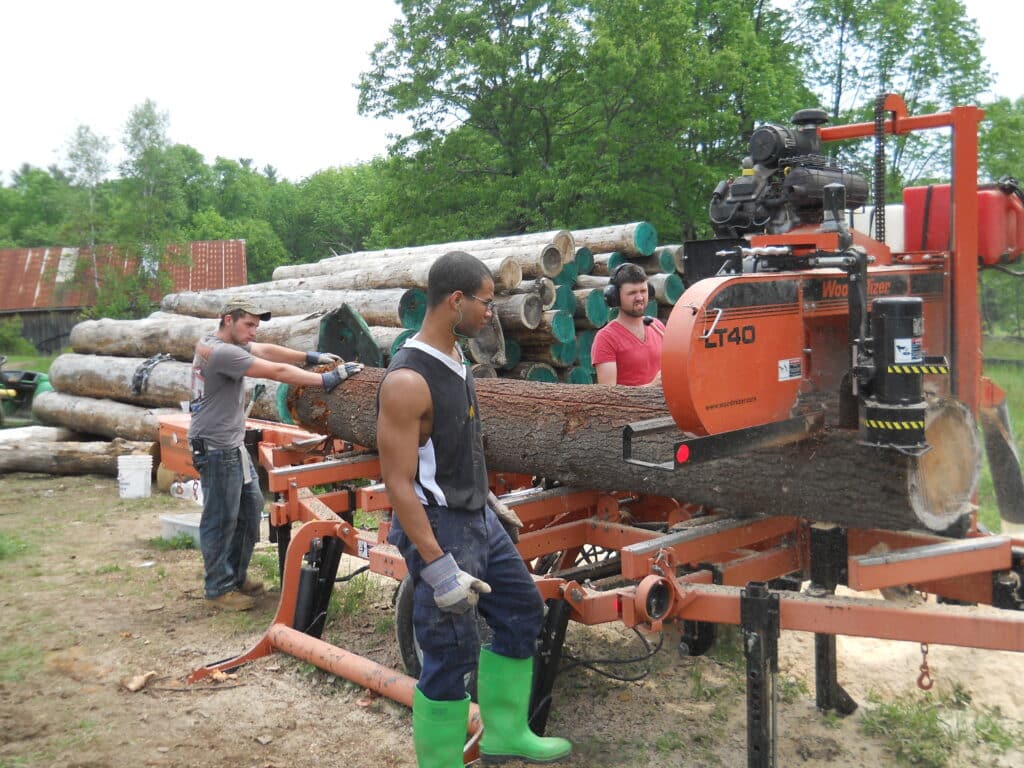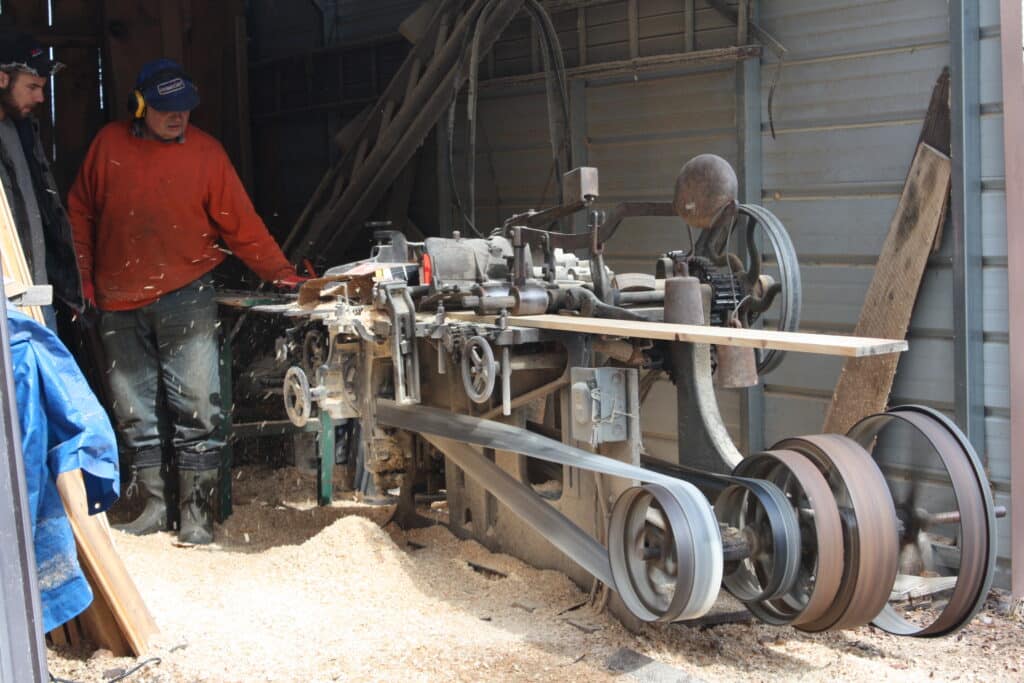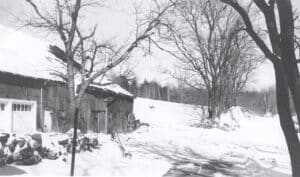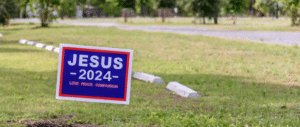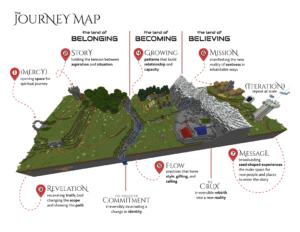The Beginnings of Promise Woods
After volunteering at camp for a year and a half in 2007–2008, Kenton Baer returned as construction supervisor to take on a much larger project: building the first cabin in the area that would become known as Promise Woods. “The decision to go back to camp in 2012 was quite simple,” Kenton said. “It was just perfect timing in my life to do a project like this. The motivation came from falling in love with camp and all that camp stands for in my previous stay.”
When Jim Baer—Kenton’s father—lived at camp, he was part of a group that had discussed and dreamed about the building of cabins for children’s camp at the setting where Promise Woods now exists. Rough plans had even been drawn up.
“I was not aware in the beginning that when my dad lived at camp he was on a committee that wanted to build cabins at that same spot,” Kenton said. “He even drew up a rough sketch of the plans. That made it extra special for me, for sure. I don’t know how many people get to complete something like that, so long in the making. What are the odds that I’d get to complete part of my dad’s vision 30 years later?”
“I’ve never had any official schooling for building, and I’d never built a stand-alone building before the cabin at camp. I had built a tiny log cabin at home. I just decided to take it on. I like to learn as I go, and I’ll take something on whether I’ve done it before or not. I have to thank my dad, though, for being the best teacher ever. And what is special about camp is whether you know what you’re doing or not, you can figure it out when you’re there. If you’re the only one there to do it, you do it.
“When I arrived at camp in 2012 they had a concept drawing of the cabins. I spent a few weeks tweaking those initial plans and along with Sean and Ken’s insight we came up with a more revised version to take to an architect. At this point the project suddenly became difficult. Initially camp was working with a Pennsylvania timber framing company as the architect. After we met with them about the drawings, we quickly realized they were not going to be able to provide us with what we needed to build a commercial building in New York state.
“At that point we decided to sit down and draw the buildings by hand in hopes that if we had actual sketches it would be easier to convey our plan to the next company. We then found a local guy that was more than qualified to make up these simple cabin drawings. The problem was he was probably over qualified and a bit out of touch with our reality. I believe in his mind we were building skyscrapers that needed every little detail specified to astringent standard. He wanted me to take some steps that were just not necessary for a small cabin.“
Anyway, we finally ended things with him and were on to the next guy. At this point we were all pretty discouraged about the situation. Thankfully the next architect was the perfect fit. He understood our vision for the project and was just a joy to work with. He was happy to take all the suggestions and plans we had made and turned them into what we needed to proceed.
“Using white pine from camp to build the cabins was such a joy. To be able to tell people that all the wood they see in the cabins was grown and cut at camp, and never went farther than the bottom of Brandt Road—to Dennis Smith’s for milling—was so satisfying. Using our own wood was definitely a learning process, with a few mistakes made. Camp initially cut down way too many trees before the project was underway and in doing so lost a lot of wood to bugs and nature doing its thing. This was not, however, a totally bad thing. As I began to realize the logs were becoming unusable for building, I became more selective and picked out just the best logs for sawing. This made for more wasted material, but in the end I was able to get a higher grade of lumber for the cabins. We also were able to make mountains of wood chips out of the less desirable logs, which were used for walking trails and mulching all around the camp property. So in the end our mistake was not all bad!
“One thing I will say is that working with volunteers changed me. I’m the first to admit I’m not very good with working with volunteers. To coordinate a group and work together is not my strong suit. I’ll never forget the first group of volunteers I worked with. I wasn’t prepared and about 20 things went wrong. In the end it worked out, but I redid some things and maybe ruffled some feathers. But I improved over time and one of the greatest perks of working on the cabin project was getting to work alongside many skilled volunteers. I learned so much from them—everything from plumbing and electrical skills to how to perfectly tuck a pencil under my hat for quick and easy access on the job!”
When asked if there were any design elements he was especially pleased with, Kenton noted, “The porches were originally supposed to be smaller. We were able to make them larger and I’m happy that we did that. People like to sit on porches and enjoy the scenery and each other’s company. And something a bit funny is a fancy door I made which leads to the mechanicals loft; it’s above the bedroom and you need a ladder to access it. I didn’t mean for it to look so inviting. It’s only about 4’ high. But everyone wants to go up there when they see the door. There are just wires and maintenance items in there.”
Kenton ended up building four cabins and lived in the maintenance house on the top of the hill for just under three years, until July of 2015. “I hadn’t committed to that,” said Kenton, “and maybe that lack of planning drove Ken a little crazy, but it worked out.” Ben Cheek replaced Kenton in 2015 and is presently working on the fifth and sixth cabins as well as the program center.
“I appreciate everything about camp, especially the variety of people,” Kenton said. “People come from everywhere. And they all come there and enjoy the same thing—beautiful mountains and the big front yard. Every-one seems to have a meaningful time there. I was not involved with summer camp, but seeing kids running around and having a blast—that made it for me.”
“I didn’t sleep in one of the cabins until over a year after they were in operation. It was nice to finally get to enjoy a night in something I put so much thought and time into. I hear comments about the cabins when I’m at camp, or even once at my church in Pennsylvania when someone let me know they had liked staying in one of the cabins during a visit to camp. I know the cabins are definitely appreciated.”
—Written by Donna Stoltzfus, former camper and staff.
Kenton Baer, volunteer 2007–08, Promise Woods construction supervisor 2012–2015.
Related Entries
Share:
Pain and Need Aren’t Partisan
This is Session 3 of the Prince of Peace: Jesus and Peacebuilding from the Election to the Holidays webinar series. (Click here to sign up for session invites.) Sometimes people seem so different from us, we automatically assume we can’t connect. Or, we tried to connect on some level, but it quickly became way too…
What is A Mission Statement?
On the LMC NYC District call this month, Dr. Tiffany shared critical information on what is and what is not a mission statement. This is critical as we think about moving the congregations in our district forward towards mission, optimize the mission already underway, and align together on the LMC mission as district churches. In…
Advent Calendar
Count Down the Days to Christmas with Camp! Jesus is the center of our Camp community. Let’s celebrate together the coming of the One who brings peace and salvation and life everlasting to humanity. We’ll be posting each day to Facebook and Instagram stories, but you can get our daily post in your email inbox!…
A Spirit-filled Christmas: The Joy in Judgement
The end of this week (Black Friday) marks the beginning of the Christmas season for many. (Though the big-box retailers had stuff out before Halloween, can you believe it!?!) For our culture, this season is a time of Joy. We gather for feasting and presents and the delighting of children. And despite the growing chill…
From Inner Peace to the Holiday Table
This is Session 2 of the Prince of Peace: Jesus and Peacebuilding from the Election to the Holidays webinar series. (Click here to sign up for session invites.) This session is about what we do when the people around us challenge our peace. It requires us to draw on something deeper in order to continue…
Releasing and Loving “The Other Side”
This is Session 1 of the Prince of Peace: Jesus and Peacebuilding from the Election to the Holidays webinar series. (Click here to sign up for session invites.) This session is about what we do with those in our lives who see things differently — even very differently. We do this using a paradigm from…
Story of A Tree
A fresh tree stump is like a magnet to me. I have to look at the rings to read the tree’s story. It’s at once humbling to look inside a living thing that is much longer-lived than yourself, but also encouraging to see how it weathered the ups and downs of life, the good times…
Camp’s Political Endorsement
I’ve been eligible to vote for 30 years, but – like many in my generation – I’ve never felt like a politician or party truly represented me. They may win me at one point, but they’ll loose me in the next. When I have voted, it always seemed I was going to the polls holding…
Prince of Peace
Camp’s mission statement says we offer people the opportunity to fellowship in “serenity”. Serenity literally means “clear skies” — a state of refuge from the storms of the World. Right now, our World does feel pretty stormy with a divided country going into an election and numerous disasters and conflicts abroad and at home. Because…
Mapping Spiritual Journey with NYC Leaders
In order to know where you’re going, it’s a good idea to know where you are. One of the best ways to know where you are is a good map. The NYC LMC District is seeing growth in many of our churches right now, and opportunities for re-inventing and re-launching in others. But these are…
- « Previous
- 1
- 2
- 3
- Next »

